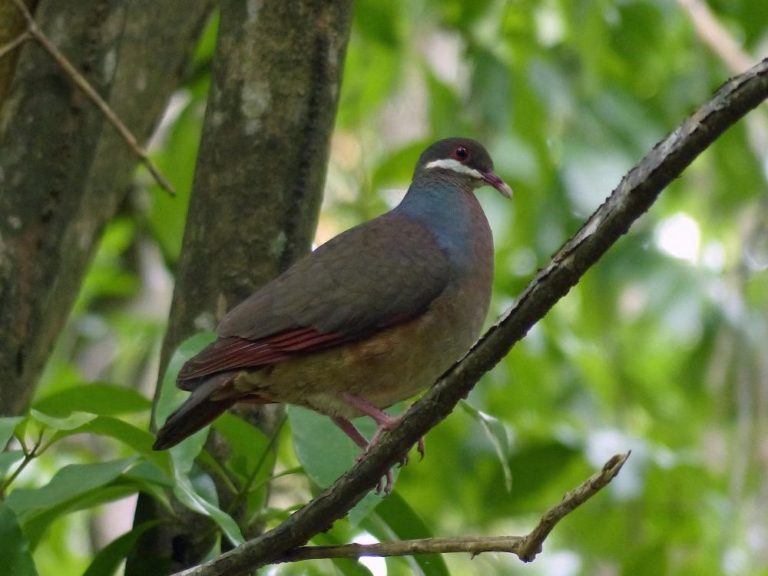Birdfinding.info ⇒ Uncommon overall, but still locally common where humid forest remains on St. John, St. Croix, Saba, St. Kitts, Montserrat, Guadeloupe, and its southern satellites (Terre-de-Basse, Terre-de-Haute, and Marie-Galante). Sites where it can often be found include: several of the trails in Virgin Islands National Park on St. John; the northwestern corner of St. Croix; Romney Manor on St. Kitts; and Cascade aux Ecrevisses and Corossol on Guadeloupe. On Vieques, it could be found consistently at upper elevations of Monte Pirata until 2017, when Hurricane María devastated that small forest. The two majoor hurricanes of 2017 that targeted its range (Irma and María) severely damaged habitat and reduced populations on some other islands as well, notably St. Eustatius.
Bridled Quail-Dove
Geotrygon mystacea
Endemic to the eastern Antilles from Puerto Rico to St. Lucia, but apparently absent from Anguilla, St. Martin, St. Barthelemy, Antigua, and Barbuda. Its status on Puerto Rico and Vieques is unclear—there are very few records from Puerto Rico in recent decades, and little of its habitat remains intact on Vieques.
Occurs primarily in humid montane forests, but also locally down to sea level and in dry forest—sometimes beside the seashore in dense stands of Sea Grape.
Identification
Dark brown upperparts with an iridescent mantle and cowl, brown and gray underparts, and a strikingly bold white whisker stripe.
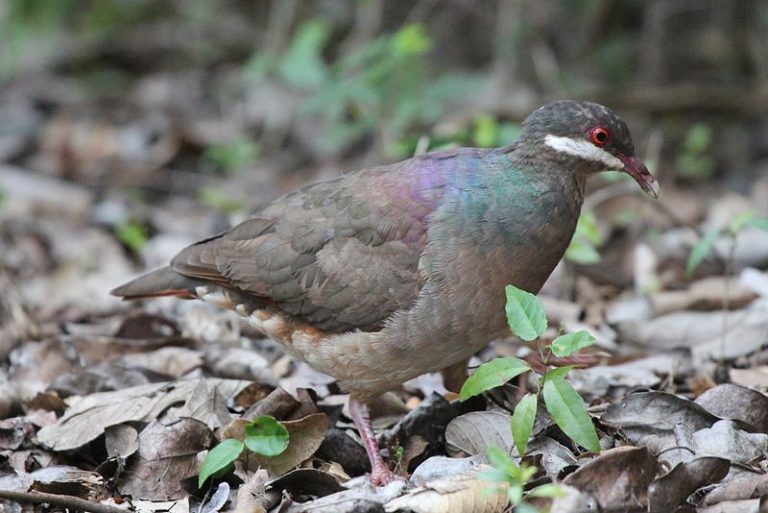
Bridled Quail-Dove. (St. John, U.S. Virgin Islands; July 22, 2012.) © Jason Crotty
The iridescence is typically green or blue on the neck and purplish or magenta on the mantle, but this varies somewhat depending on the lighting.
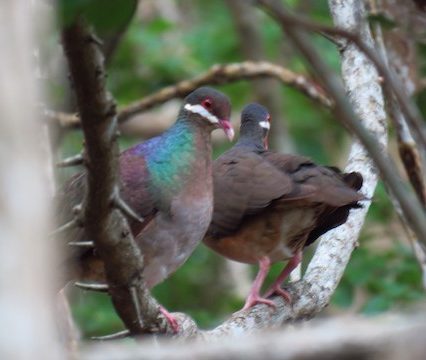
Bridled Quail-Dove. (Quill National Park, St. Eustatius; November 27, 2015.) © Robert Wellens
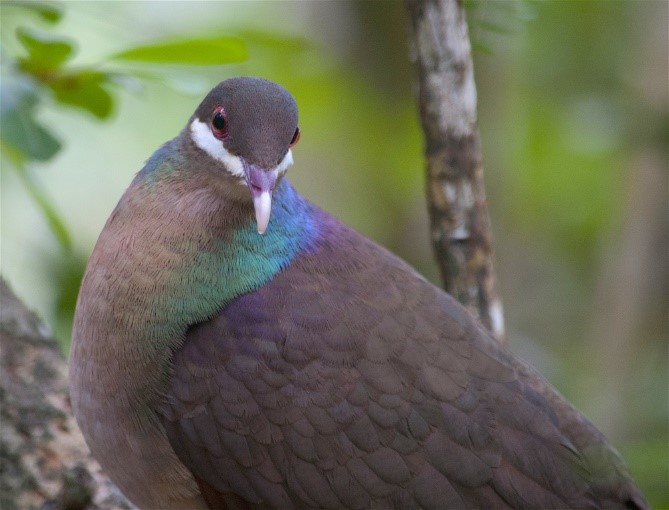
Bridled Quail-Dove, showing green and blue iridescence on the neck. (Quill National Park, St. Eustatius.) © Hannah Madden
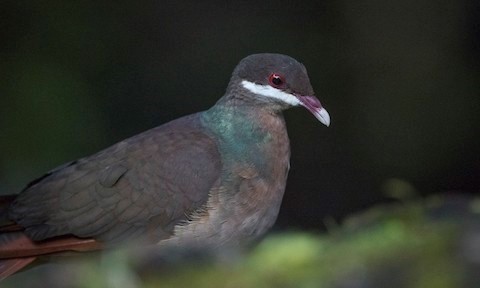
Bridled Quail-Dove, showing only green iridescence on the neck. (Cascade aux Ecrevisses, Guadeloupe; March 4, 2018.) © Brian Sullivan
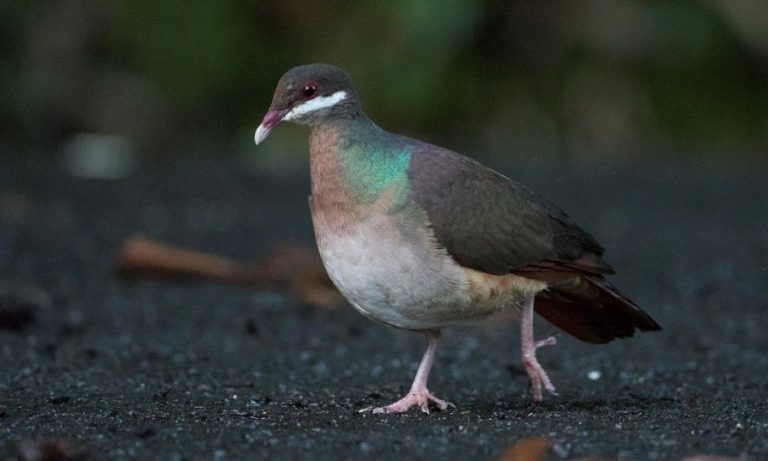
Bridled Quail-Dove. (Cascade aux Ecrevisses, Guadeloupe; March 4, 2018.) © Brian Sullivan
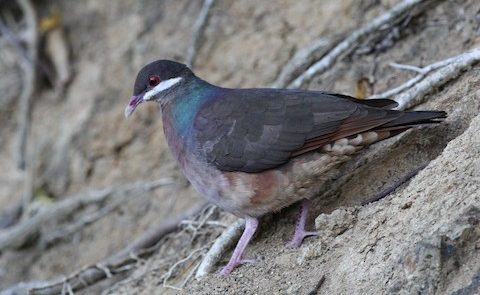
Bridled Quail-Dove. (Terre-de-Haute, Guadeloupe; February 25, 2019.) © Harold Forsyth
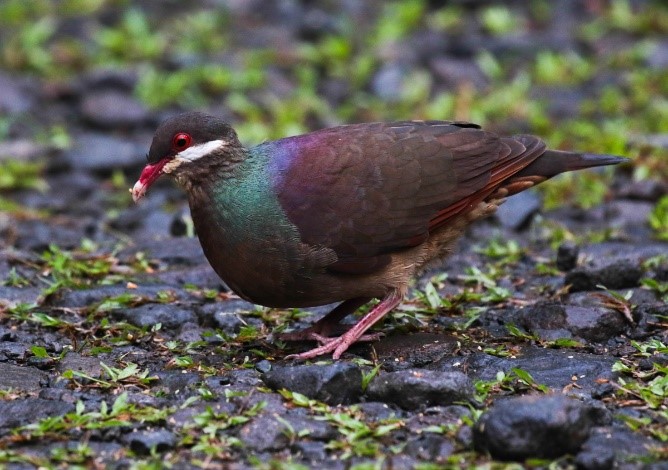
Bridled Quail-Dove, showing typical iridescence. (Guadeloupe National Park, Guadeloupe; May 30, 2019.) © Alan Lewis
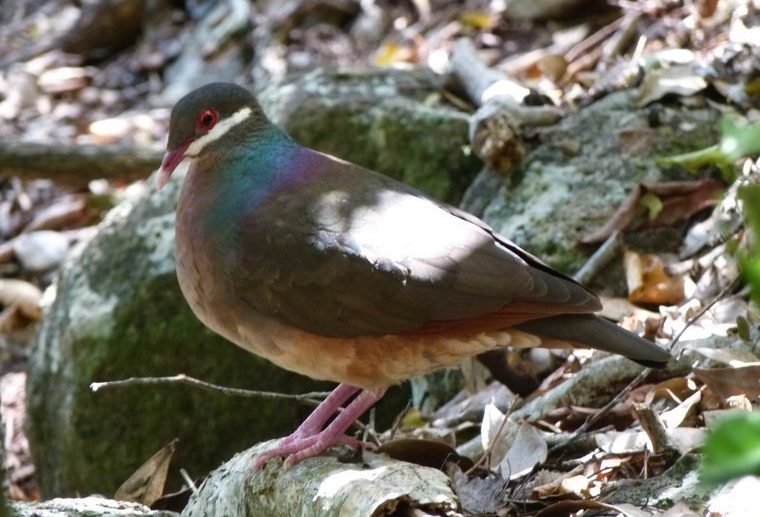
Bridled Quail-Dove, showing green and blue iridescence on the neck. (Terre-de-Bas, Guadeloupe; February 16, 2013.) © Augustyniak
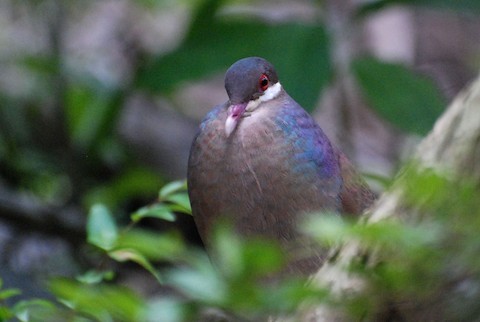
Bridled Quail-Dove, showing blue and violet iridescence on the neck. (Virgin Islands National Park, St. John, U.S. Virgin Islands; November 14, 2018.) © Robert Dobbs
The flight feathers are bright rufous, often visible at rest and extremely conspicuous in flight. Also visible mainly in flight is a bright coppery patch on the axillaries and sides that is concealed under the folded wing.

Bridled Quail-Dove, showing contrasting rufous flight feathers. (Monte Pirata, Vieques; January 11, 2016.) © Christoph Moning
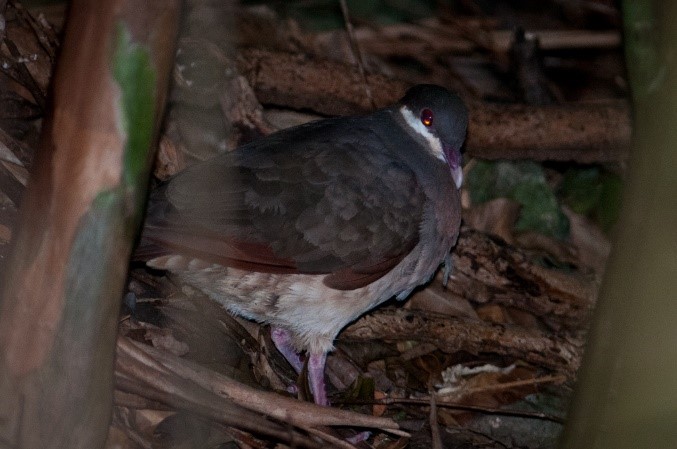
Bridled Quail-Dove. (Virgin Islands National Park, St. John, U.S. Virgin Islands; January 20, 2011.) © Stephen John Davies
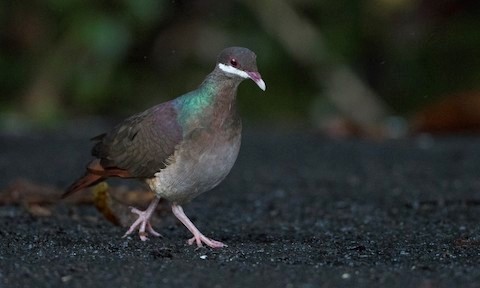
Bridled Quail-Dove. (Virgin Islands National Park, St. John, U.S. Virgin Islands; January 20, 2011.) © Stephen John Davies
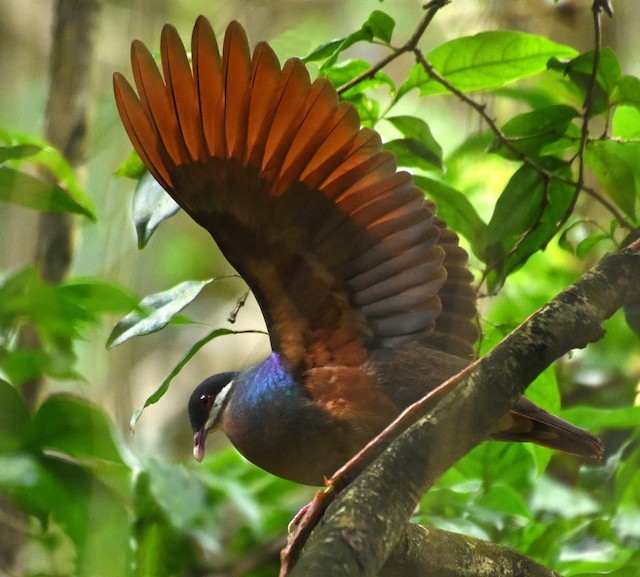
Bridled Quail-Dove, showing its rufous flight feathers—also note the bright coppery patch on the axillaries and sides. (Romney Manor, St. Kitts; March 4, 2018.) © Steven Mlodinow
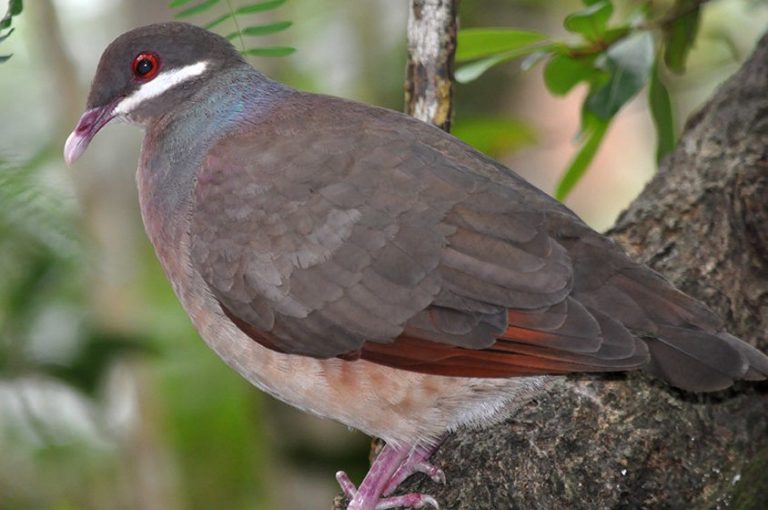
Bridled Quail-Dove, showing contrasting rufous flight feathers. (Quill National Park, St. Eustatius.) © Hannah Madden

Bridled Quail-Dove, showing buffy belly and rufous flight feathers. (Carr’s Bay, Montserrat; April 17, 2018.) © Bird Explorers
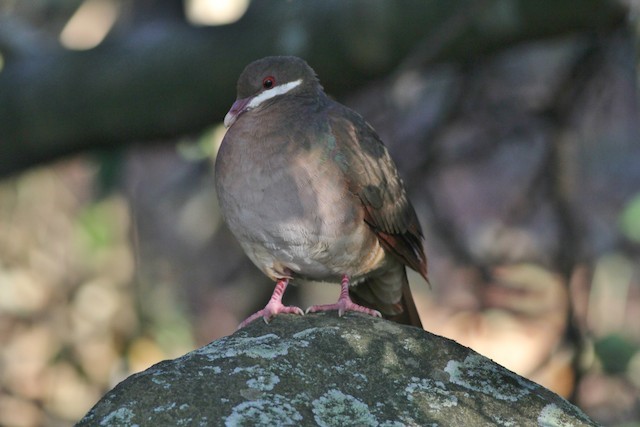
Bridled Quail-Dove, ventral view. (Terre-de-Haute, Guadeloupe; February 24, 2019.) © Harold Forsyth

Bridled Quail-Dove, apparent immature showing contrasting rufous flight feathers. (St. John, U.S. Virgin Islands; January 5, 2011.) © Corey Raimond
Immatures are duller overall, with little iridescence, but otherwise similar to adults.
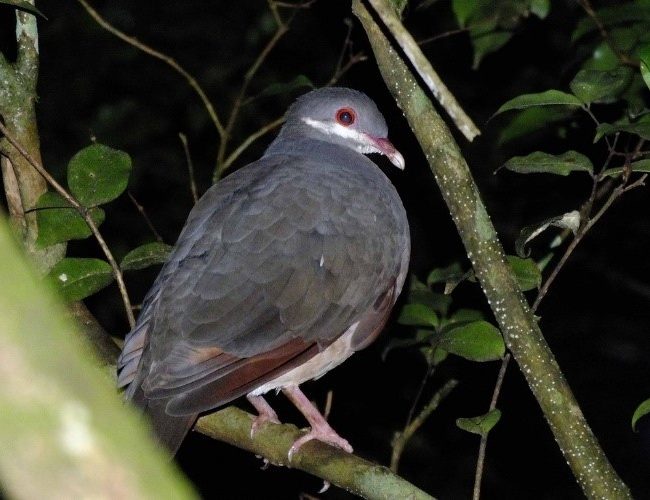
Bridled Quail-Dove, apparent immature showing contrasting rufous flight feathers. (Saba; October 12, 2013.) © Erik van der Woude

Bridled Quail-Dove, showing contrasting rufous flight feathers. (St. Kitts; January 16, 2019.) © Ronald Werson

Bridled Quail-Dove, ventral view. (Monte Pirata, Vieques; January 11, 2016.) © Christoph Moning

Bridled Quail-Dove, immature. (St. John, U.S. Virgin Islands; July 22, 2012.) © Jason Crotty
Cf. Key West Quail-Dove. Key West and Bridled Quail-Doves overlap to some extent on Vieques and Puerto Rico—and as both species sometimes move between islands, occasional overlap elsewhere is also possible. On Vieques they have distinct habitat preferences: Key West is found in “evergreen scrub and palmetto forest” at low elevations, and Bridled in “moist fan palm forest” on the island’s highest peaks. (Gemmill 2015)
Key West is recognized by its grayish underparts (including the breast and throat), and reddish brown back and wings. In adequate light, Key West shows more extensive iridescence: greenish on the cap and nape, transitioning to pinkish purple on the upper back and wings. Bridled’s iridescence is dimmer and usually appears as a cape that varies from greenish to violet-purple.
Their vocalizations differ: Bridled calls in polysyllabic phrases, whereas Key West gives single-note calls, and Bridled’s voice is somewhat higher-pitched.
Notes
Monotypic species.
References
Baptista, L.F., P.W. Trail, H.M. Horblit, G.M. Kirwan, and P. Boesman. 2019. Bridled Quail-dove (Geotrygon mystacea). In Handbook of the Birds of the World Alive (J. del Hoyo, A. Elliott, J. Sargatal, D.A. Christie, and E. de Juana, eds.). Lynx Edicions, Barcelona. https://www.hbw.com/node/54253. (Accessed September 12, 2019.)
BirdLife International. 2016. Geotrygon mystacea. The IUCN Red List of Threatened Species 2016: e.T22690958A93296362. http://dx.doi.org/10.2305/IUCN.UK.2016-3.RLTS.T22690958A93296362.en. (Accessed September 11, 2019.)
Boal, C.W. 2011. Bridled Quail-Dove (Geotrygon mystacea), version 1.0. In Neotropical Birds Online (T.S. Schulenberg, ed.). Cornell Lab of Ornithology, Ithaca, New York. https://doi.org/10.2173/nb.brqdov1.01.
eBird. 2019. eBird: An online database of bird distribution and abundance. Cornell Lab of Ornithology, Ithaca, N.Y. http://www.ebird.org. (Accessed September 11, 2019.)
Gemmill, D. 2015. Birds of Vieques Island, Puerto Rico: Status, Abundance, and Conservation. Special issue of The Journal of Caribbean Ornithology, BirdsCaribbean, Scholarly & Specialized Publishing, Charlottesville, Virginia.
Gibbs, D., E. Barnes, and J. Cox. 2001. Pigeons and Doves: A Guide to the Pigeons and Doves of the World. Yale University Press, New Haven, Connecticut.
Raffaele, H. 1989. A Guide to the Birds of Puerto Rico and the Virgin Islands. Princeton University Press, Princeton, N.J.
Raffaele, H., J. Wiley, O. Garrido, A. Keith, and J. Raffaele. 1998. A Guide to the Birds of the West Indies. Princeton University Press, Princeton, N.J.
